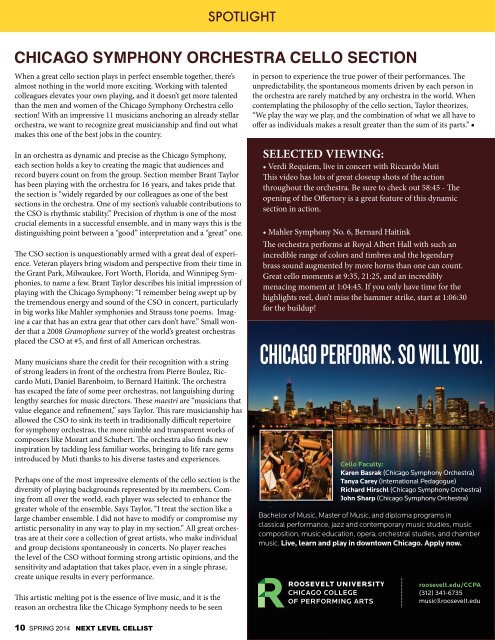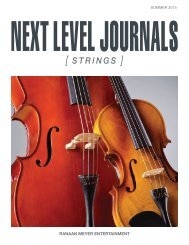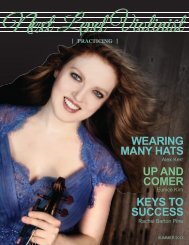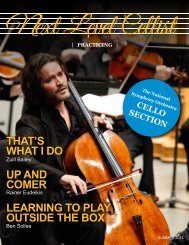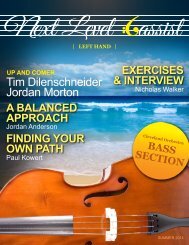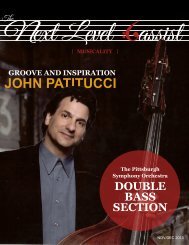Next Level Cellist Musicality Issue
Featuring articles by Alisa Weilerstein and Efe Baltacigil, a spotlight on the Chicago Symphony Cello section, and a duet by Ranaan Meyer
Featuring articles by Alisa Weilerstein and Efe Baltacigil, a spotlight on the Chicago Symphony Cello section, and a duet by Ranaan Meyer
You also want an ePaper? Increase the reach of your titles
YUMPU automatically turns print PDFs into web optimized ePapers that Google loves.
SPOTLIGHT<br />
CHICAGO SYMPHONY ORCHESTRA CELLO SECTION<br />
When a great cello section plays in perfect ensemble together, there’s<br />
almost nothing in the world more exciting. Working with talented<br />
colleagues elevates your own playing, and it doesn’t get more talented<br />
than the men and women of the Chicago Symphony Orchestra cello<br />
section! With an impressive 11 musicians anchoring an already stellar<br />
orchestra, we want to recognize great musicianship and find out what<br />
makes this one of the best jobs in the country.<br />
In an orchestra as dynamic and precise as the Chicago Symphony,<br />
each section holds a key to creating the magic that audiences and<br />
record buyers count on from the group. Section member Brant Taylor<br />
has been playing with the orchestra for 16 years, and takes pride that<br />
the section is “widely regarded by our colleagues as one of the best<br />
sections in the orchestra. One of my section’s valuable contributions to<br />
the CSO is rhythmic stability.” Precision of rhythm is one of the most<br />
crucial elements in a successful ensemble, and in many ways this is the<br />
distinguishing point between a “good” interpretation and a “great” one.<br />
The CSO section is unquestionably armed with a great deal of experience.<br />
Veteran players bring wisdom and perspective from their time in<br />
the Grant Park, Milwaukee, Fort Worth, Florida, and Winnipeg Symphonies,<br />
to name a few. Brant Taylor describes his initial impression of<br />
playing with the Chicago Symphony: “I remember being swept up by<br />
the tremendous energy and sound of the CSO in concert, particularly<br />
in big works like Mahler symphonies and Strauss tone poems. Imagine<br />
a car that has an extra gear that other cars don’t have.” Small wonder<br />
that a 2008 Gramophone survey of the world’s greatest orchestras<br />
placed the CSO at #5, and first of all American orchestras.<br />
Many musicians share the credit for their recognition with a string<br />
of strong leaders in front of the orchestra from Pierre Boulez, Riccardo<br />
Muti, Daniel Barenboim, to Bernard Haitink. The orchestra<br />
has escaped the fate of some peer orchestras, not languishing during<br />
lengthy searches for music directors. These maestri are “musicians that<br />
value elegance and refinement,” says Taylor. This rare musicianship has<br />
allowed the CSO to sink its teeth in traditionally difficult repertoire<br />
for symphony orchestras, the more nimble and transparent works of<br />
composers like Mozart and Schubert. The orchestra also finds new<br />
inspiration by tackling less familiar works, bringing to life rare gems<br />
introduced by Muti thanks to his diverse tastes and experiences.<br />
in person to experience the true power of their performances. The<br />
unpredictability, the spontaneous moments driven by each person in<br />
the orchestra are rarely matched by any orchestra in the world. When<br />
contemplating the philosophy of the cello section, Taylor theorizes,<br />
“We play the way we play, and the combination of what we all have to<br />
offer as individuals makes a result greater than the sum of its parts.” ■<br />
SELECTED VIEWING:<br />
• Verdi Requiem, live in concert with Riccardo Muti<br />
This video has lots of great closeup shots of the action<br />
throughout the orchestra. Be sure to check out 58:45 - The<br />
opening of the Offertory is a great feature of this dynamic<br />
section in action.<br />
• Mahler Symphony No. 6, Bernard Haitink<br />
The orchestra performs at Royal Albert Hall with such an<br />
incredible range of colors and timbres and the legendary<br />
brass sound augmented by more horns than one can count.<br />
Great cello moments at 9:35, 21:25, and an incredibly<br />
menacing moment at 1:04:45. If you only have time for the<br />
highlights reel, don’t miss the hammer strike, start at 1:06:30<br />
for the buildup!<br />
CHICAGO PERFORMS. SO WILL YOU.<br />
Perhaps one of the most impressive elements of the cello section is the<br />
diversity of playing backgrounds represented by its members. Coming<br />
from all over the world, each player was selected to enhance the<br />
greater whole of the ensemble. Says Taylor, “I treat the section like a<br />
large chamber ensemble. I did not have to modify or compromise my<br />
artistic personality in any way to play in my section.” All great orchestras<br />
are at their core a collection of great artists, who make individual<br />
and group decisions spontaneously in concerts. No player reaches<br />
the level of the CSO without forming strong artistic opinions, and the<br />
sensitivity and adaptation that takes place, even in a single phrase,<br />
create unique results in every performance.<br />
This artistic melting pot is the essence of live music, and it is the<br />
reason an orchestra like the Chicago Symphony needs to be seen<br />
10 SPRING 2014 NEXT LEVEL CELLIST


